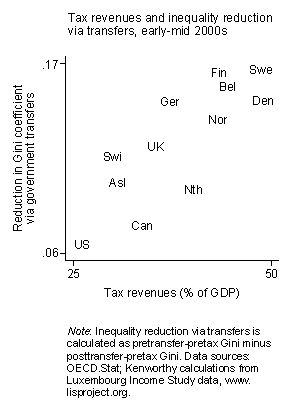TO BE NOTED: From
Consider the Evidence:
"
Reducing Inequality: Boosting Incomes in the Bottom Half April 16, 2009 So far in this series of posts on reducing income inequality in America I’ve said that it would be good if there were less inequality, that greater unionization might help but probably isn’t in the cards (even if EFCA becomes law), that more and better education would be a good thing but isn’t likely to make much of a dent in the inequality problem, and that curtailing globalization is a bad choice for progressives even if it would help a lot. So what should we do?
Recall that there are two key components of the rise in inequality: slow income growth in the lower half (or two-thirds) of the distribution and soaring incomes at the top. Let’s start with the first of these two. I think a key component of an effective and politically feasible strategy is an enhanced statutory minimum wage and Earned Income Tax Credit (EITC).
This year the minimum wage will increase to $7.25 per hour. I’d like to see it raised again in 2010, to $8.00. A more important change is to index the minimum wage to inflation. As the following chart shows, since the late 1970s the minimum wage has been allowed to languish for lengthy periods with no increase, resulting in large declines in its inflation-adjusted value. With increases in 2007, 2008, and 2009, it will be at a reasonably high level compared to the past three decades, though still below its late-1960s peak. Raising it to $8.00/hour and keeping it at that value would be a significant step in the right direction.

Is $8.00 an hour high enough? It’s difficult to tell. Two considerations make me inclined to prioritize locking in something like that level rather than aiming for a larger increase right away. The first is jobs. Opponents of raising the minimum wage often contend that any increase will produce employment declines. Our experience with past increases suggests little support for this notion, but it’s equally wrong to presume there won’t be an adverse employment effect no matter how high the minimum wage. Surely there is some level that is too high. This argues for incremental upward adjustment from a stable floor. Second, proponents of a sizable increase in the minimum often point out how inadequate it is given the cost of living in certain parts of the country. That’s quite true, but it’s probably better addressed by state and local governments stepping in with their own higher statutory minimums, as a growing number have done over the past decade.
An expanded Earned Income Tax Credit would be similarly helpful for low- and middle-income Americans. The EITC is a terrific policy: it boosts the incomes of low-earning households, it encourages employment, it has low administrative costs, it creates minimal stigma for recipients, and it’s indexed to inflation. Currently the maximum value of the credit is about $5,000, available to households with two children and with earnings between $12,500 and $19,500. It then declines steadily until it reaches zero at around $43,000 in earnings. For households with one child the credit is lower, and for those with no children it is quite small. A chart showing the current level and structure of the credit is available from the Tax Policy Center.
I’d like to see the EITC look something more like this:

This EITC would extend well into what most of us think of as the middle class. It wouldn’t provide a lot of to those with earnings above $50,000, but it would help. Phasing out the credit more rapidly (making the slope of the line on the right side steeper) risks creating work disincentives. Moreover, there’s a potential political advantage to including those with higher incomes. When the middle class uses the same programs as the poor, it tends to be more supportive of those programs; the “us” versus “them” mentality that weakens support for social policy is likely to have less political bite. This EITC expansion would not be cheap. I’ll say a bit about how to pay for it in a future post.
With these changes in the minimum wage and the Earned Income Tax Credit, a single adult working full-time year-round at minimum wage would have an income — earnings plus EITC — of approximately $19,000, compared to 15,500 under current policy. A family of four with two minimum wage earners would have an income of about $38,500, compared to $32,500 currently. That’s not a full solution to the inequality challenge, but it’s a good start."










































